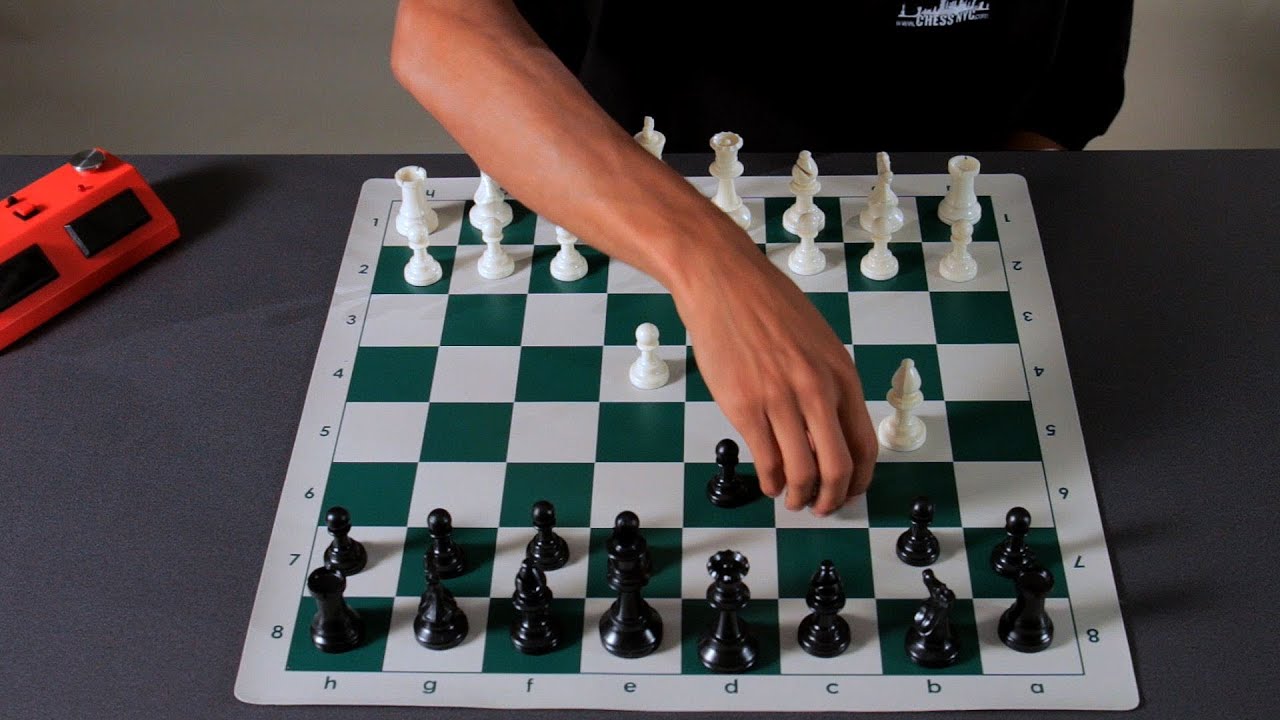Learn Chess Step by Step Here: https://www.youtube.com/playlist?list=PLLALQuK1NDriznzxP5rQkQwKIrGSWRMZF ——————— My 60 Memorable Games Paperback: http://amzn.to/1G0y1IB Bobby Fischer Teaches Chess Mass Market: http://amzn.to/1R1DJua Complete Book of Chess Strategy: Grandmaster Techniques from A to Z: http://amzn.to/1htal3R Watch more How to Play Chess videos: http://www.howcast.com/videos/514260-Principles-of-Attacking-and-Defending-Chess Okay, guys. We’re going to talk about attack and defense, but in the most rudimentary way possible because this is really what chess is all about. Volumes have been written about attack and defense. But, we’re going to deal with this in the most straight forward way. Let’s say white does E4, maybe the most common opening in chess. Black goes E5. Now, the most logical and probably the most expected continuation is knight to F3. Why? Because, we need to develop our pieces, our bishops and our knights immediately. So why not develop the knight that attacks black’s central pawn. Now, this could be defended in a few ways. We could go, for example, bishop D6, but that not something you are likely to see a strong player do because you’re blocking your queen’s pawn and, therefore, your queen’s bishop. And, it’s just creating space problems for no reason. You could go D6. Although, you’re falling behind in development. There’s plenty of opening systems where D6 is acceptable, but be careful not to fall too far behind in development. We could go queen to E7, but that’s not really logical because you’re blocking your king’s bishop which needs to be developed. So, the most common way to defend this E5 pawn and not fall behind in development would be knight to C6, keeping up with white in development and simply defending your E pawn. Now of course, if white were to make the absurd move of knight takes pawn, black would go knight takes knight and would be winning the game, immediately. But, white’s not going to make that terrible mistake. They’ll probably develop the bishop to C4 for the Italian game or B5 for the Spanish game, or maybe knight to C3 for the Scotch game. But, that’s an example of how to defend a pawn and how to use some basic principals in choosing how to do so. Another quick example would be if I start with E4 and let’s say black goes D6, which would be the beginning of the Pirc Defense or perhaps any number of other defenses, if I go bishop B5 check, a check I don’t personally recommend, it could be blocked in any number of ways. We could block with the queen. That would be a terrible move, losing the queen for absolutely no reason, and subsequently losing the game. We could block with the bishop, which is pretty good because then if I go bishop takes bishop, I’m giving black the opportunity to develop their knight. Or, I could just go C6 and deflect the bishop, which is now retreating and maybe is going to get hit again with B5 and will have to retreat to B3 and so on. But the point is, this initial check, bishop to B5 can be blocked in any number of different ways. It can be blocked with the pawn, the bishop, the queen, which would be awful. Oh, and the knight, which I didn’t mention before. Knight to C6. Knight to D7. So, there’s any number of ways to defend this position. And, a big part of being a chess player is deciding which is the best way to defend. So, I would just recommend C6; make white retreat his bishop. Those are the most basic of the basics when it comes to attacking and defending.

Chess Video – 4
- Post author:
- Post published:May 14, 2021
- Post category:Uncategorized
- Post comments:0 Comments
You Might Also Like

HIGH INTENSITY SHORT DURATION EXERCISE GETS YOU LEAN NOT CARDIO

Vitamin B12 Functions In Our Body |Hindi| Vitamin B12 Source – Supplements

Heart Anatomy Part 1
Glutamine Supplement

ANDROGEN RECEPTOR DNA THROUGH PHENOTYPE

What does ornithine mean?

Reason for LDL Increase for Some on a Low Carb Diet

Overhead Shoulder Press (3 MISTAKES!)

Hill sprints: Increase power, build muscle & burn fat

Critical Care Medicine Video – 1

Yoga Trainer Personality Video – 4

8 Foods to Avoid During Pregnancy II Pregnancy Diet Plan II Diet in First Trimester to Third Trimest

Severe Cystic Acne – Timelapse (Version 1)

Micronutrition Pt 2 – Antioxidants and Phytochemicals

Triceps Pulley Extension-7

Lat Pulldown with Band : Best Back Exercises ( Lat exercises )

Try This Rear Delt Exercise Next Shoulder Day

Metabolic Rate

How to build your home gym cheap: build your own triceps pulley to do the triceps pushdown

Sciatic Pain | sciatica pain relief exercises | sciatic nerve

Is it normal to get a prescription for propranolol?

Suicide Psychology/ Psychiatry Video – 2

ENT Surgery Video – 3

How to Read Nutrition Facts | Food Labels Made Easy

Catabolism

Tricor To Lower Triglycerides and Bad Cholesterol in the Blood – Overview

Standing Calf Raise

Pulley Curl-5

How to Get the Most out of Vitamin Supplements- Thomas DeLauer
Lat Pull Down-6

Human Body, Body Building Muscle Building Anatomy Physiology Video – 21

Preacher Curl for Bicep Mass

Swiss Ball Bicep Curls

All essential Vitamins & Supplements | Timings & Dosage…

Hormone control of hunger

#7 Metabolism I anabolism I catabolism
Latissimus Dorsi Bent Over Row-5

Circulatory System Heart BP And Asanas Video – 3

Liver Damage Symptoms

Thyroid Test – Simple DIY Test At Home

Seated Calf Raise-4

